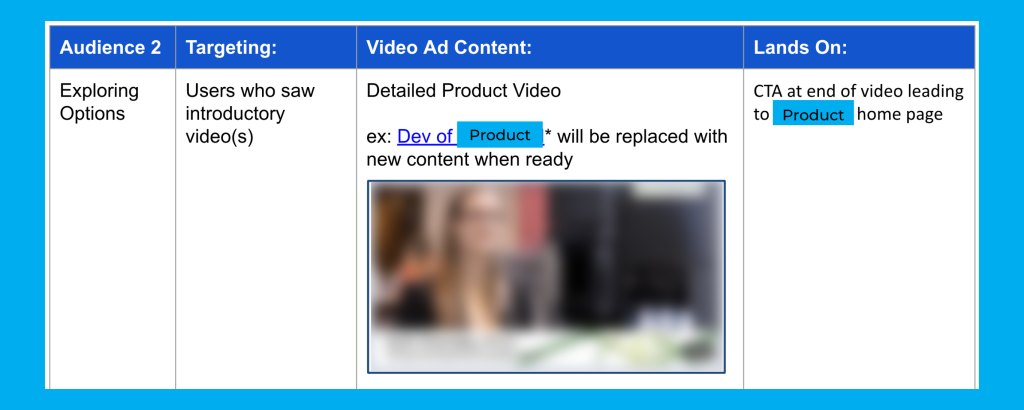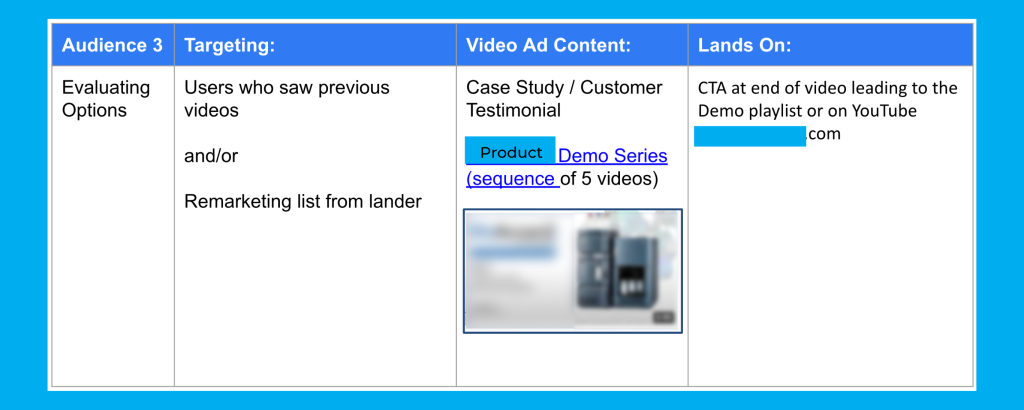As a B2B marketer, you know customers won’t convert on the basis of a single text ad.
This is especially true of our life science clients who develop and market complex lab equipment that they sell for five- to six-figures.
With one of these clients, we work with two teams: Lead generation and e-commerce.
Recently, their B2B lead generation team asked us to help them educate and build awareness of a complex lab product they had recently updated.
Here’s how we incorporated video ads into our B2B advertising strategy for this product.

Targeting three audiences
Our client identified three different audiences at various stages in the decision-making funnel:
- Recognizing needs
- Exploring options
- Evaluating options.
We then developed campaigns to target each of these groups with video advertising.
Audience group #1: Recognizing needs
We defined Audience #1 as those in the “recognizing needs” stage of their decision-making process. These audience members were in the process of realizing they had an unmet need and weren’t sure how to resolve it.
Thus, our goal for this audience was to confirm that unmet need and introduce them to our client’s brand and product.
For this audience, we had two video assets we could use: an animated infographic video and a general product overview video. Both video ads included a call to action that took visitors to the product page on the company’s website.
We targeted these ads to custom intent audiences in Google Ads, using top keywords, competitor names, and relevant scientific sites to define those audiences (as outlined in the table below).

Audience #2: Exploring options
We defined Audience #2 as people in the “exploring options” stage of their decision-making journey. They knew they had an unmet need and were researching different ways to solve it.
This audience was made up of people who were formerly in Audience #1. Once they watched the video ads for Audience #1, they “moved” to Audience #2 for remarketing.
The goal at this stage was to help Audience #2 with their decision making by giving them more detailed information about the client’s product.
Luckily, we had several videos suitable for this audience, including one where a scientist describes the product at a deeper level and its recent improvements (see table below).
Each video included a CTA that took viewers to the product home page.

Audience #3: Evaluating options
Audience #3 was in the “evaluating options” phase of their decision making. They had narrowed down their list of solutions and now needed to make a choice.
We defined Audience #3 as people who had already visited our client’s website or watched any of the Audience #1 or #2 video ads.
The goal for this audience was to deliver even more detailed information about the product to aid decision making. We used demo videos and case studies in our video ads to provide leads with more information as well as social proof.
Each video ad ended with a call to action that took viewers to a playlist on our client’s YouTube channel that contained even more product demo videos (see table):

Three additional tips for B2B lead generation with video ads
In the course of implementing this B2B video advertising strategy, we were reminded of a few important things that make these types of campaigns successful.
Length of video ads
First, conventional wisdom about video advertising doesn’t always hold true.
It’s generally accepted that video ads perform better when they’re shorter in duration. Google itself notes that video ads that are less than three minutes tend to perform better.
However, this “rule” is worth testing.
For our life sciences client, for example, we’ve achieved great success with videos as long as five minutes in all of these audience groups.
If your video content is targeted and aligned with your leads’ decision-making process, longer duration videos can work really well.
Excluding audiences
Second, when building the types of audiences described above, whether for Lead generation or e-commerce campaigns, whom you EXCLUDE can be every bit as important as whom you INCLUDE.
For example, whenever a lead converts, you need to exclude them from all audience groups. You don’t want to annoy your lead, or waste your budget, by continuing to target them with advertising after they’ve spoken with a salesperson, made a purchase, or converted in some other way.
Remarketing
Third, remarketing to viewers of all videos is an integral part to this strategy. We like to retarget via the Google Display Network as well the Search Network (i.e. ads on Google.com).
Make video advertising part of your B2B lead generation campaigns
We’re pleased to report that this video advertising strategy is working really well for our life science client, and we’ll be using it as inspiration for similar campaigns for other clients.
Because it proves, once again, that video ads are often the perfect vehicle to promote complex B2B products and services.






